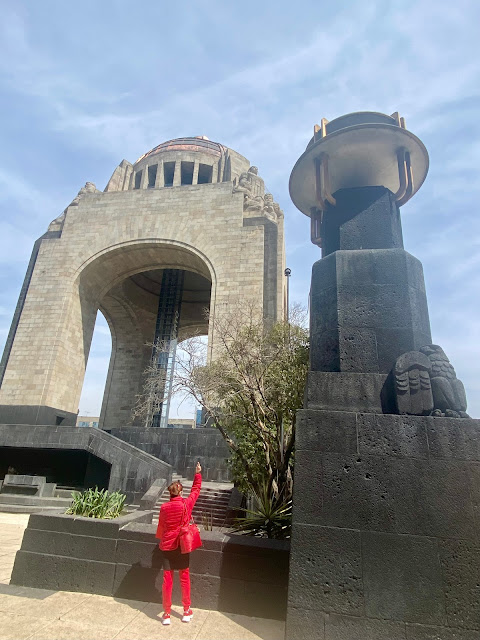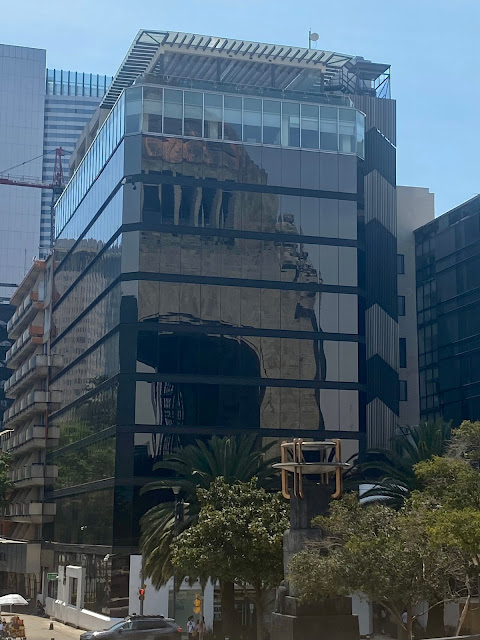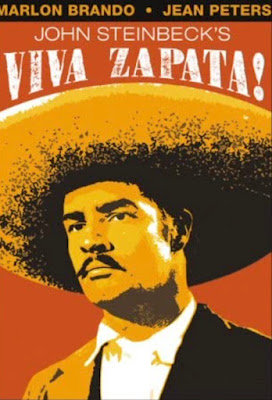Did this woman have eyes in the back of her head? I loved the contrast of her red outfit with the Monumento a la Revolución but she gave me the finger when I photographed her from behind. Or maybe she was delivering her own private message about Mexico's complicated political history.
Chris and I walked to the monument from the Airbnb on yet another sunny, cool morning through a lovely neighborhood where the brunch crowd, hungry for huevos rancheros, had begun to fill restaurants with outdoor tables after a night of partying. I paid more attention to the decor and architectural details.
The Paseo de la Reforma, one of the city's grandest boulevards, had been closed to motor vehicular traffic.
A pair of tourists consulted their guidebook on this wrought iron bench.
Eagles adorn the bases of the four pillars that support the monument.
Pancho Villa and other heroes of the Mexican Revolution which unseated Porfirio Díaz after a three-decade dictatorship are entombed in the pillars but access to their memorials isn't permitted on Sundays. This man chose to nap in front of a general who served briefly as president during the political chaos that ensued when the Porfiriato ended.
American gun advocates would point to this bizarre display of plastic rifle replicas in the monument's foundation as incontrovertible evidence for their support of the second amendment to the U.S. Constitution. I might argue the same if they were running our government. People don't win revolutions, guns do.
A glass elevator in the center of the monument delivers you to the first observation deck, just below the windows.
You must climb the stairs to the upper deck.
Construction began before the revolution when it was supposed to house the new, rubber-stamping Mexican Parliament, whom Diaz described as "a herd of tame horses."
As you can see in the architectural model displayed in the museum downstairs, an eagle holding a snake in its beak, the symbol of Mexico, was supposed to plug the hole at the top of the rotunda.
The revolutionaries, in a justified cost-cutting mood, turned the stable into something altogether different, or as we say in America, they made lemonade out of an enormous lemon and transformed the rotunda into a monument. You can't beat the views
. . . or the reflection!
Doesn't Díaz, depicted here by Stalinist David Alfaro Siqueiros remind you of the Monopoly man? The Mexican dictator, once a liberal soldier who fought a French takeover of his country, prioritized foreign investment above democracy. That said, he stabilized Mexico and modernized it, summarily killing at least 10,000 people who got in his way.
So-called "Bad Mexicans," brought him down with "dulces y escobas" or "candy and brooms," their code words for rifles and ammunition.
Emiliano Zapata and Pancho Villa were among the baddest Mexicans. Both were disavowed by Francisco Madero, a "spiritist" who became president after the fall of Díaz in 1911 because they were more interested in land reform than politics. Marlon Brando, a native of Omaha, Nebraska, received an Oscar nomination for "Viva Zapata," a 1952 film written by John Steinbeck and directed by Elia Kazan before he was blacklisted.
Mustaches and sombreros do not a Mexican revolutionary make, although the movie is quite stirring!
Zapata looks a lot fiercer in this mural-size portrait by Siqueiros, which hangs in the Museo Soumaya.
In the power struggle that followed the assassination of President Madero in 1913, Villa, allied with Zapata, nearly became president himself until the United States threw its weight behind his nemesis, another general who eventually led the country. Villa then tried to provoke the U.S. into invading Mexico by raiding Columbus, NM, a border town, with a small band of loyalists. When my father and I drove there on a dirt road in the 60s, it was inhabited by ghosts.
The U.S. Army couldn't capture Villa despite the superiority of its military and equipment.
By the time we exited the monument, hundreds of bicyclists had gathered on the plaza below. It was the only time I smelled weed during the trip.


























No comments:
Post a Comment